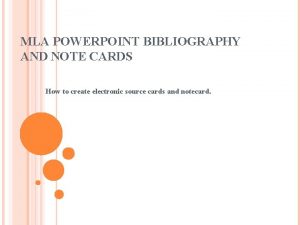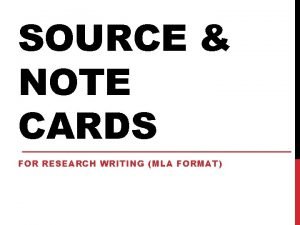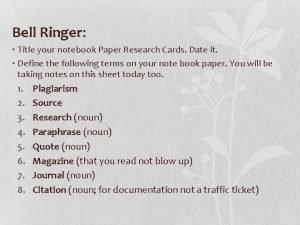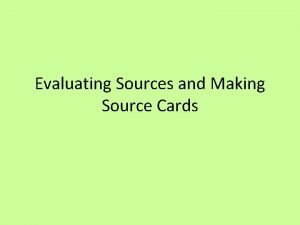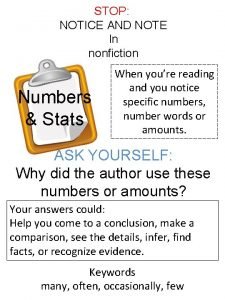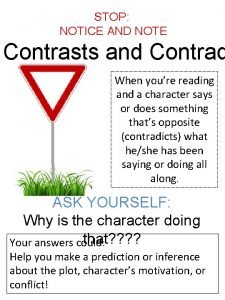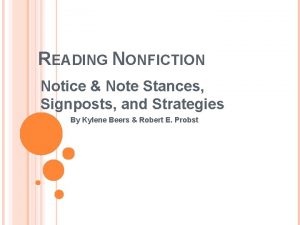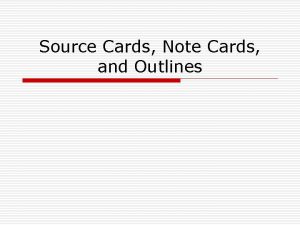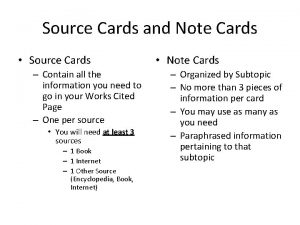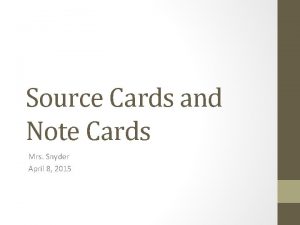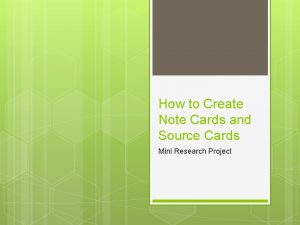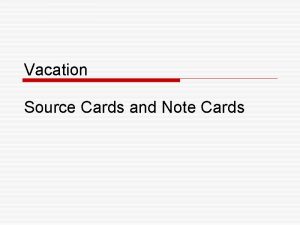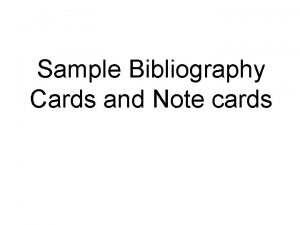Source Cards and Note Cards SOURCE CARDS What
























- Slides: 24

Source Cards and Note Cards

SOURCE CARDS

What goes on a Source Card? • All of the information necessary for the Works Cited entry • A different number (1, 2, 3) or a letter (A, B, C) for each different source

Why make source cards? They will help you to: – identify the sources of quotations and ideas for citing your sources later – find sources again if you need them. – make your Works Cited page

How to do it: • Use index cards to make your source cards, or keep a few notebook pages reserved for this information, or make a word processing or other computer software for them. • Use only one card per source. • Code each source its own number or letter, starting with the number 1 (or A). You can later link your notes to these code numbers.

How should it look? Source Number Author Article Title Page Title Date written Date Accessed URL

NOTE CARDS

What goes on a Note Card? • The topic of your information • The number of the source card it is from • Information (quotes, data, statistics and other paraphrased info) you collect about your topic from your sources. • The page # or location of the information

4 Items to include on Note Card Paraphrased Information or Direct Quote in quotation marks (“ … “) / Location

Card Topic: Topic is the kind of information on the card. Think of it as the title, or main idea of the card. After writing down the information, figure out how you could briefly categorize, or title it.

Card Topic: For example, if you are writing a paper on the life and works of the poet, Langston Hughes, you may have cards with topics such as: • • • Hughes' upbringing Hughes' influences Hughes' poetry Hughes' political beliefs Hughes' influence on America

Source Number: • The source number is the number from the source card of the book, magazine, website, etc. , in which you found the information.

Paraphrased info: • It is helpful to paraphrase, or summarize, your research on the index cards while you are taking notes. • If you are consistent in paraphrasing at this stage, then you will be certain not to accidentally plagiarize someone else's work. • You will also have less work to do when you are actually writing the paper.

Direct Quote: • Direct quotes from sources should be copied word-for-word and put in quotation marks (“. . . “) on the note card. • Be sure to indicate who the quote is from, either the author or another source who was quoted in the writing.

Data and Statistics: • Should be VERY carefully copied onto your note card. • Be sure to give the original source credit. (Often the surveys and questionnaires completed to collect data and statistics are not conducted by the publisher or author of your source. Search carefully to find the original source of the information. ) Original source

Page numbers/Location: • It is important to be accurate with the page numbers (if available) on your note cards, as you will need them for citations throughout your research paper.

Page numbers/Location: • When using a Web or other source which lacks page numbers, it is useful to make a note of the location of the information. For example: Your source may be www. langstonhughes. 8 m. com, but you may have taken information from both the ‘BIOGRAPHY’ page and the “CRITICAL RESPONSES’ page

So your note card may look like this: Hughes Poetry Critical Responses pg Location

Combination Source and Note cards: Front • If you only take one or two small pieces of information from a source, you may want to put the source information on the front, and the note information on the back. 6 Brown, David “Life and Times of Langston Hughes” Great Poets of the 20 th Century 6 2003 24 Feb 2011 <http: //langstonhughes. 8 m. com/custom 3. html> “Money was a nagging concern for Hughes throughout his life. While he managed to support himself as a writer, no small task, he was never Back financially secure. ” Biography Pg

Be careful not to crowd too much information on one card Should look like this …. Not this! 3 Hughes background 3 • born February 1 st 1902 in Joplin Missouri, Hughes background • son of Carrie Langston Hughes and James Nathaniel Hughes February 1 st 1902 in Joplin Missouri, under the given name of James Langston Hughes, the son of Carrie Langston Hughes and James Nathaniel Hughes. Shortly after he was born his parents separated. His mother moved around from city to city searching for work in childhood, Hughes lived in Mexico, Topeka, Kansas, Colorado, Indiana and Buffalo. When he was a child he lived with his grandmother for a time, when he was 13 he moved back with his mother and her new husband. After he graduated from high school he spent a year with his father in Mexico who had become a successful cattle rancher. In 1917 he wrote many great poems and became recognized by other African-American and White authors and poets. In 1923 he was published in several magazines and won critical acclaim for his work. He is known for starting the Harlem Renaissance and for putting black writers on the main stage • lived in Mexico, Topeka, Kansas, Colorado, Indiana and Buffalo. Biography Pg Biography pg

Other options for creating source/note cards: Computer Programs Make sure you keep the source information carefully

Other options for creating source/note cards: Microsoft Word

Other options for creating source/note cards: Your own paper 4 Brown, David “Life and Times of Langston Hughes” Great Poets of the 20 th Century 2003 24 Feb 2011 <http: //langstonhughes. 8 m. com. . html> 4 Background Info “Money was a nagging concern for Hughes throughout his life. While he managed to support himself as a writer, no small task, he was never financially secure. ” Biography Pg

Citing my source! Information for this presentation came from the following source: “Researching and Organizing Your Paper: The Note Card System. ” English Works! at Gallaudet University, Washington, D. C. Published: 1997 present. Retrieved 7 March, 2006. < http: //depts. gallaudet. edu/englishworks/writing/notec ard. html>
 Source card meaning
Source card meaning Difference between note making and note taking
Difference between note making and note taking Signal words for cause and effect
Signal words for cause and effect Difference between note making and note taking
Difference between note making and note taking Debit note format
Debit note format What is debit note and credit note
What is debit note and credit note Note taking and note making
Note taking and note making Financial documents in order
Financial documents in order Simple discount
Simple discount Mla powerpoint citation
Mla powerpoint citation Example note cards for a research paper
Example note cards for a research paper Quotation note card
Quotation note card Bibliography note cards
Bibliography note cards Source cards
Source cards Note card format
Note card format Notecards for research paper
Notecards for research paper Note card for presentation
Note card for presentation What are source cards
What are source cards Bibliography cards definition
Bibliography cards definition Source card definition
Source card definition Notecards for research paper
Notecards for research paper Infohio
Infohio Extreme or absolute language
Extreme or absolute language Stop notice and note
Stop notice and note What did the author think i already knew
What did the author think i already knew









